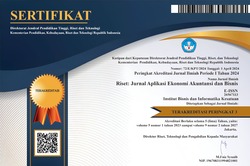EFFECT LEADERSHIP STYLE AND ORGANIZATIONAL CULTURE ON PERFORMANCE WITH WORK MOTIVATION AS INTERVENING VARIABLE
DOI:
https://doi.org/10.37641/riset.v5i1.163Keywords:
Leadership Style, Organizational Culture, Performance, Work MotivationAbstract
With work motivation as an auxiliary variable, this study seeks to ascertain the impact of leadership style and organizational culture on the performance of specialist doctors. This study is a cross sectional study with 65 specialist doctors as respondents. Collecting data for the four variables using a linkert scale of 1-5 points and as a test tool descriptive statistical analysis is used with a three box method approach which is divided into three scale ranges, namely H (High), M (Medium), and L (Low). The results of the analysis of sub-structure 1 and the probability value simultaneously and partially indicating that the leadership style, organizational culture, and work motivation simultaneously and partially have a positive and substantial impact on performance. Sub structure 2 and the comparison of probability values simultaneously and partially shows that simultaneously and partially leadership style and organizational culture have an effect positive and significant effect on work motivation. The equation of path of total influence shows that job motivation influences leadership style and organizational culture in a way that enhances the performance of specialist doctors.
Downloads
References
Baig, S. A., Iqbal, S., Abrar, M., Baig, I. A., Amjad, F., Zia-ur-Rehman, M., & Awan, M. U. (2019). Impact of Leadership Styles on Employees’ Performance with Moderating Role of Positive Psychological Capital. Total Quality Management & Business Excellence, 32(9–10), 1–21. https://doi.org/10.1080/14783363.2019.1665011
Beauty, M., & Aigbogun, O. (2022). Effects of Leadership Styles on Employee Performance: A Case Study of Turnall Holdings LTD, Harare. International Journal of Academic Research in Business and Social Sciences, 12(1), 290–305. https://doi.org/10.6007/ijarbss/v12-i1/12037
Bernardin, H. J., & Russell, J. E. A. (2016). Human Resource Management (Translated). Bandung: Armico.
Blanchard, K., Zigarmi, P., & Zigarmi, D. (2013). Leadership and the One Minute Manager Updated Ed: Increasing Effectiveness Through Situational Leadership II. New York: William Morrow. https://www.amazon.com/Leadership-Minute-Manager-Updated-Effectiveness/dp/0062309447
Boamah, S. A., & Tremblay, P. (2019). Examining The Factor Structure of The MLQ Transactional and Transformational Leadership Dimensions in Nursing Context. Western Journal of Nursing Research, 41(5), 743–761. https://doi.org/10.1177/0193945918778833
Dessler, G. (2017). Human Resource Management (8th ed.). New Jersey: Prentice Hall. https://www.amazon.com/Human-Resource-Management-Gary-Dessler/dp/0130141240
JCI. (2014). National Patient Safety Goals. The Joint Commission. https://www.jointcommission.org/standards/national-patient-safety-goals/
Kreitner, R., & Kinicki, A. (2016). Organizational Behavior. New York: McGraw-Hill. https://www.worldcat.org/title/organizational-behavior/oclc/806268317?referer=di&ht=edition
Kuntz, L., Scholten, N., Wilhelm, H., Wittland, M., & Hillen, H. A. (2020). The Benefits of Agreeing on What Matters Most: Team Cooperative Norms Mediate The Effect of Co-leaders’ Shared Goals on Safety Climate in Neonatal Intensive Care Units. Health Care Management Review, 45(3), 217–227. https://doi.org/10.1097/HMR.0000000000000220
Labrague, L. J., Al Sabei, S., Al Rawajfah, O., AbuAlRub, R., & Burney, I. (2022). Interprofessional Collaboration As A Mediator in The Relationship Between Nurse Work Environment, Patient Safety Outcomes and Job Satisfaction Among Nurses. Journal of Nursing Management, 30(1), 268–278. https://doi.org/10.1111/jonm.13491
Lee, H.-W. (2019). Performance-Based Human Resource Management and Federal Employee’s Motivation: Moderating Roles of Goal-Clarifying Intervention, Appraisal Fairness, and Feedback Satisfaction. Review of Public Personnel Administration, 39(3), 323–348. https://doi.org/doi.org/10.1177/0734371X177213
Luthans, F. (2016). Organizational Behavior: An Evidence-Based Approach (12th ed.). USA: McGraw-Hill.
Mathis, R. L., & Jackson, J. H. (2016). Human Resource Management. Jakarta: Salemba Empat.
McCaffrey, R., & Reinoso, H. (2017). Transformational Leadership: A Model for Advanced Practice Holistic Nurses. Journal of Holistic Nursing, 35(4), 397–404. https://doi.org/10.1177/0898010116685242
Nikolova, I., Caniëls, M. C. J., & Sverke, M. (2022). Qualitative Job Insecurity and Extra Role Behaviours: The Moderating Role of Work Motivation and Perceived Investment in Employee Development. Economic and Industrial Democracy, 1–26. https://doi.org/10.1177/0143831X221081167
Nungchim, B. N., & Leihaothabam, J. K. S. (2022). Impact of Organizational Culture on the Effectiveness of Organizations: A Case Study of Some Service Sector Organizations in Manipur. Jindal Journal of Business Research, 11(1), 44–54. https://doi.org/10.1177/22786821221082592
Robbins, S. P. (2016). Organizational Behavior (17th ed.). New Jersey: Pearson Education. https://scirp.org/reference/referencespapers.aspx?referenceid=2647298
Robbins, S. P., & Judge, T. A. (2017). Organizational Behavior (5th ed.). New Jersey: Pearson Education. https://www.academia.edu/50945037/Organizational_Behavior_By_Stephen_P_Robbins_Timothy_A_Judge_5th_Ed
Schein, E. H. (2017). Organizational Culture and Leadership (3rd ed.). California: Jossey-Bass. http://www.untag-smd.ac.id/files/Perpustakaan_Digital_2/ORGANIZATIONAL CULTURE Organizational Culture and Leadership, 3rd Edition.pdf
Tomic, B., Brkić, V. S., Karapetrovic, S., Pokrajac, S., Milanović, D. D., Babić, B., & Djurdjevic, T. (2017). Organizational Culture, Quality Improvement Tools and Methodologies, and Business Performance of a Supply Chain. Proceedings of the Institution of Mechanical Engineers, Part B: Journal of Engineering Manufacture, 231(13), 2430–2442. https://doi.org/10.1177/0954405416629100







